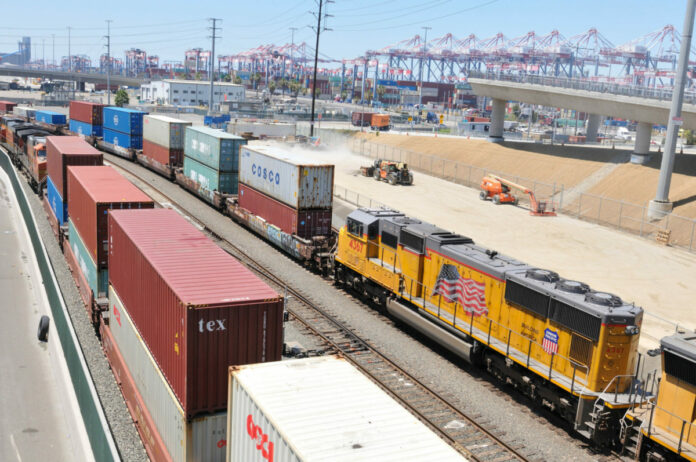The port of Long Beach, one of the busiest cargo facilities in the world, has completed construction on its latest rail line, a project that aims to expand capacity and improve the movements of goods at the congested port. It is also expected to have environmental benefits.
The Port of Long Beach finished construction on the project, which added a second rail line that now allows four terminals to manage arriving and departing trains simultaneously, in late April.
The project, dubbed Double Track Access, is located in the port’s south basin. It spans from Pier G to Pier J and is almost 8,000 feet long. The Pier G-J project improves on-dock rail capacity so that more cargo can be transported to and from marine terminals in the Port of Long Beach by train, without the need for a truck trip.
Built at a cost of $34.7 million, the project came in $900,000 under budget and one week ahead of schedule.
Wilmington-based Pacific Harbor Line Inc. – the switching railroad for the San Pedro Bay port complex – uses the track, in addition to national rail lines Union Pacific Railroad Company and BNSF Railway, in coordination with PHL.
Reducing traffic
The project increases capacity and on-dock rail use by 157,000 TEUs per year. A TEU is a “twenty-foot equivalent unit” — the standard metric for ocean containers. One 20-foot-long container is equivalent to one TEU, whereas a 40-foot-long container is two TEUs.
The rail project was designed to reduce truck traffic at the nation’s second-largest seaport, which for years has been plagued by backups.
The project is also expected to improve air quality and reduce the impact on the neighboring communities, which was one of the key objectives of the San Pedro Bay Ports Clean Air Action Plan.
“This project is an important piece of the rail improvement program that will increase efficiency and lower emissions at our Port,” Long Beach Mayor Robert Garcia said in a statement. “We’re continuing to invest in strengthening our supply chain, prioritizing environmental sustainability and reducing impacts on the communities surrounding the Port.”
The benefits are clear: on-dock rail offers efficiencies in moving cargo to and from marine terminals compared to drayage trucking. The rail also creates less air pollution emissions than trucking, a port representative told The Business Journal.
“Alleviating truck traffic will enhance air quality and decrease the impact of Port operations on the surrounding community,” Sharon L. Weissman, vice president of the Long Beach Harbor Commission, said in a statement. “Moving goods more efficiently and sustainably remains one of our top priorities.”
A single on-dock train replaces the need for as many as 750 drayage truck trips. In addition, going directly to and from marine terminals by rail streamlines cargo movement by eliminating the need for additional cargo-handling moves at off-dock rail terminals.
On-dock rail trains serving the San Pedro Bay ports complex make use of the Alameda Corridor, a rail line that connects the ports to the national rail network with a grade-separated line that eliminates the need for vehicle traffic to wait at rail crossings along the 20-mile route. The use of the Alameda Corridor also minimizes port-related truck traffic on the 710 Freeway.
Funding
Construction on the project commenced in February 2020 and was funded in part by a $14 million grant from the state’s Trade Corridor Enhancement Program. The program was established to pay for infrastructure improvements on federally designated freight networks across California using money from the state and the National Highway Freight Program.
The Long Beach Port put up the remaining funds for the project.
The Double Track Access increases rail efficiency by almost 25% and will reduce conflict with neighboring terminals’ on-dock rail operations and improve overall safety in the area.
“This project will streamline operations and reduce truck trips at a time we are experiencing an unprecedented growth in cargo,” said Mario Cordero, executive director at the Port of Long Beach, said in a statement. “Our investments in on-dock rail will help the Port remain globally competitive and environmentally sustainable well into the future.”

Other projects
The Double Track Access rail project isn’t the only one planned to help ease congestion at the port. The Port of Long Beach is also in the midst of a roughly $1 billion rail capital improvement program.
The goal is to get to the point where the facility will be free of cargo trucks and will, instead, rely on smaller train segments that will be brought to the facility and joined together into a full-sized train.
In December, the port was awarded a $52.3 million grant from the U.S. Department of Transportation’s Maritime Administration to assist in the development of the “Pier B On-Dock Rail Support Facility,” which is considered the “centerpiece” of the $1 billion rail improvement program.
Construction on the Pier B On-Dock Rail Support Facility is slated to begin in 2023. The first arrival, departure and storage tracks are expected to be completed in 2025, with additional tracks coming online in 2030, followed by project completion in 2032.
The port has been working in conjunction with federal, state, and local officials to develop other solutions to move goods more efficiently. Goals include 24-hour terminal operations and the digitization of data.
Last month, President Joseph Biden met with port officials at the San Pedro Bay ports complex to address investments aimed at bolstering trade and building a resilient supply chain. The meeting aboard the USS Iowa coincided with the final day of the Summit of the Americas, where Biden had introduced his Americas Partnership for Economic Prosperity to drive economic growth across the U.S.

